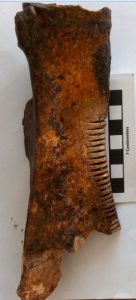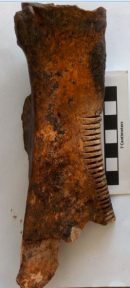
Shoulder blade with notches carved along one side (see left edge, next to scale).
Some days ago University of Chicago student Gwen Christy excavated a fine example of a notched scapula, that is, a (in this case) cow’s shoulder blade incised with many notches running along one side of it. What was its purpose? These are known objects in archaeological sites in the Levant and Cyprus (mainly) but no one agrees on what their use(s) was/were. The truism in archaeology is that when we don’t know what something is, it must be cultic – and in this case too scholars have assigned the objects a religious function, perhaps divining future events in vague parallel with the use of differently modified scapulas from ancient China, a ritual known as ‘scapulomancy’. Others have suggested more mundane uses: the bridge of a stringed musical instrument (could it withstand the strings’ tension?), separating strands of yarn during weaving (would the notches have been deep enough to hold in the threads?), or making rasping sounds while a stick or bone was rubbed against it, perhaps during a ritual (but the area of the notches shows no where from such repeated actions). Other ideas have come to my mind — maybe the notches were used in accounting or for marking calendrical time. Yet, the notches are quite uniform, which suggests they were all made at once. So, although we now have one of the best-preserved examples of this object, the enigma continues.

2 Comments